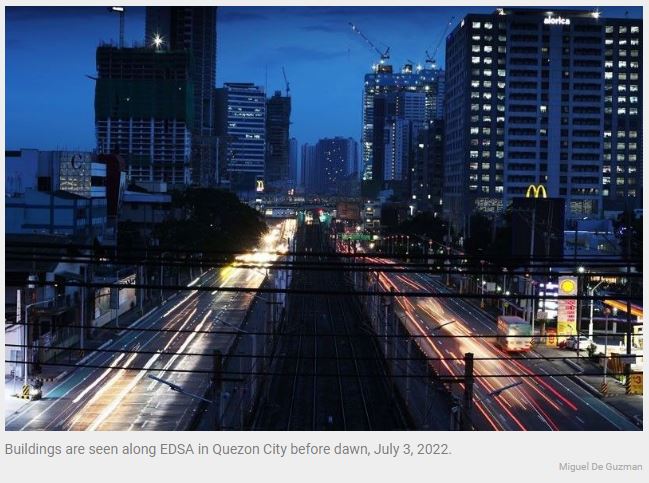Philippines: Budget gap eases to P1.6 trillion in 2022 as economy reopens
MANILA, Philippines — The country’s budget shortfall slightly narrowed last year, with its share to the overall economy also easing, after the government secured better revenue streams as business activities returned to normalcy with COVID cases declining.
Data from the Bureau of the Treasury showed that the deficit in 2022 shrank by 3.35 percent to P1.61 trillion from the 2021 level of P1.67 trillion as the growth in revenue managed to outpace overall state spending.
In turn, the deficit, when measured against the gross domestic product (GDP), eased to 7.3 percent last year from the record 8.6 percent in 2021, as the economy grew at an over four-decade high of 7.6 percent.
The budget gap is 2.2 percent below government expectation of a P1.65-trillion shortfall. Similarly, the deficit-to-GDP ratio is also below the 7.58 percent target of the Cabinet-level Development Budget Coordination Committee.
Still, the deficit means that the government is spending beyond what it earned from revenue collections, although at a much softer pace.
ING Bank senior economist Nicholas Mapa said better fiscal numbers reflect the improvement of revenue streams as economic growth improves.
Mapa added that a sustained improvement in the fiscal space can be expected but can be threatened by headwinds that may slow the country’s growth momentum.
But Leonardo Lanzona, economist and professor at the Ateneo de Manila University, argued that the high inflation last year caused an increase in government revenues.
“Higher inflation could have pushed up nominally the incomes of taxpayers and allowed the government to borrow money at higher rates and earn more interest income on its holdings of government bonds,” Lanzona said.
“But these effects are short-term in nature since inflation reduces real economic growth. In effect, all of these gains are just on paper,” he said.
To further improve the country’s fiscal space, the government needs to generate additional revenue, which can be done through the imposition of new tax measures.
However, such a move continues to be far from the plans of the economic team.
“Given that the administration does not appear to be inclined to implement new taxes, we expect the ratio to stay elevated for some time,” Mapa said.
This year, the government’s economic team aims to cut the deficit-to-GDP ratio to 6.1 percent and further to 5.1 percent by 2024.
As the Philippine Development Plan pushes for economic transformation, Lanzona emphasized that additional taxes are needed beyond what is currently implemented to achieve such a goal.
“Instead of raising taxes directly, the government allowed inflation to reduce the value of money, which in turn reduced the real value of outstanding debts and generated extra revenues,” Lanzona said.
“However, relying on inflation as a revenue source is generally seen as a harmful policy, as it can lead to economic instability, uncertainty, and distortions in the economy,” he said.
Meanwhile, data showed that total revenue collection last year improved by 18 percent to P3.55 trillion as against the P3 trillion in 2021, with the Bureau of Customs (BOC) and Bureau of Internal Revenue (BIR) both posting increases.
This is also 7.3 percent higher than the full-year program of P3.3 trillion.
Bulk or 91 percent of the revenues were from tax collections at P3.22 trillion, up 17 percent. Non-tax collections also improved 24 percent to P352.2 billion in 2022.
BIR’s haul grew 12.4 percent to P2.34 trillion while Customs saw its collection jump 34 percent to P862.4 billion from P643.6 billion in 2021.
However, BIR slightly fell short by two percent from its P2.39 trillion programmed collection while BOC exceeded its target collection by nearly 20 percent.
The Treasury said BOC’s revenue performance was driven by efforts to ensure the recovery of deficient duties and taxes, improve tax compliance, tariffs on rice imports, and public auctions of overstaying cargo.
Further, income generated by the Treasury went up 23 percent to P154.8 billion on the back of higher remittances of dividends on shares of stocks, income from Bond Sinking Fund investments, and interest on national government deposits.
Collection from other offices including privatization proceeds and fees and charges for the month also picked up 24 percent to P170.4 billion, including the one-off remittances from the Department of Social Welfare and Development and Philippine Charity Sweepstakes Office and higher collections from the Bases Conversion and Development Authority and the Department of Foreign Affairs.
Source: https://www.philstar.com/business/2023/03/02/2248568/budget-gap-eases-p16-trillion-2022-economy-reopens


 Thailand
Thailand




